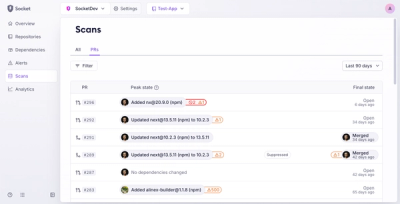
Research
/Security News
DuckDB npm Account Compromised in Continuing Supply Chain Attack
Ongoing npm supply chain attack spreads to DuckDB: multiple packages compromised with the same wallet-drainer malware.
@minka/mass-transfer
Advanced tools
Process of preparing a mass transfer offline using a command line tool.
The purpose of this tool is to sign and distribute large number of transfers in a secure way without consuming the Minka API or implementing the SDK on the originator side.
All the movements of balances in the Minka Cloud are initiated by messages derived from private keys that are generated at the source. The management of the keys is the responsibility of the source and it is recommended to prepare the mass-transfers offline if you are not using the API interface.
Since all transfers are signed using asymmetric cryptography the signed transfers could be sent using any channel.
The tool also provides a secure way to submit the transfers to protect the information in transit and requires a user login. Credentials should be obtained directly from Minka.
First step is to install the mass-transfer package on the local computer or server:
$ npm install -g @minka/mass-transfer
Generate the initial template files with mass-transfer init:
$ mass-transfer init
Successfully generated files:
* keys.json
* mass-transfer.csv
* transfer.js
mass-transfer.csv is a file that contains information about transfers that need to be executed. This is a standard CSV file with columns defined on the first line, the file can contain any number of columns which can be used in order to construct transfers, for example:
source,target,amount
wNHUK4M9VdHrALYMbSytAWPBXFonGSiJev,$573002414264,10000.00
wNHUK4M9VdHrALYMbSytAWPBXFonGSiJev,$573002414265,30000.00
wNHUK4M9VdHrALYMbSytAWPBXFonGSiJev,$573002414266,10000.00
wNHUK4M9VdHrALYMbSytAWPBXFonGSiJev,$573002414267,10000.00
transfer.js serves as a template for building transfers, it allows using any column from the mass-transfer.csv file in order to generate a new transfer object.
The configuration is a js file so it gives a the flexibility to use the full power of JavaScript, in case it is necessary to implement some more advanced logic when building transfers:
module.exports = csvData => ({
source: csvData.source,
target: csvData.target,
amount: csvData.amount,
symbol: '$tin',
labels: {
description: 'Transaction description',
domain: 'tin',
type: 'SEND',
sourceChannel: 'MassTransferCLI'
}
})
The originator can use the standard template file to create transfers, no modification or development is necessary for standard payouts or requests.
keys.json is a file that should contain the keys used to sign transfers. Those keys should be setup in advance and added to the file before signing transfers.
The file contains a mapping from addresses to keys:
{
"wNHUK4M9VdHrALYMbSytAWPBXFonGSiJev": {
"scheme": "ed25519",
"public": "041d8bf211ab07e1b66f82090fde3815bddd4ae8b8d313db5788c0990f58a8b8d65a33737c02c547de3e03d8624833a62042e9ef178ffbc84c821a457c3119603b",
"secret": "0a57b7bad498a251cbb47b369e5eed70dc1fdb039d0370fce624406240a84466"
}
}
Secret or private key is critical data that should handled with care. Private keys are used to modify balances and should not be shared to the Minka Cloud or any intermediary in the process.
After everything is in place, a client needs to sign all transfers in the file with the sign command:
$ mass-transfer sign mass-transfer.csv
Successfully created signed transfers!
Output file: mass-transfer-signed.csv (8.14 MB)
This command will create a new CSV file (mass-transfer-signed.csv) that will have an additional column called transfer in each row with a signed transfer built from the data of that row:
source,target,amount,transfer
wNHUK4M9VdHrALYMbSytAWPBXFonGSiJev,$573002414263,10000.00,"{ ""source"": ""wNHUK4M9VdHrALYMbSytAWPBXFonGSiJev"", ""target"": ""$573002414263"", ""amount"": 10000.00, ""symbol"": ""$tin"", ""labels"": { ""description"": ""Transaction description"", ""domain"": ""tin"", ""type"": ""SEND"", ""sourceChannel"": ""MassTransferCLI"", ""transferSignature"": ""<signature>"" }}"
wNHUK4M9VdHrALYMbSytAWPBXFonGSiJev,$573002414264,30000.00,"{ ""source"": ""wNHUK4M9VdHrALYMbSytAWPBXFonGSiJev"", ""target"": ""$573002414264"", ""amount"": 30000.00, ""symbol"": ""$tin"", ""labels"": { ""description"": ""Transaction description"", ""domain"": ""tin"", ""type"": ""SEND"", ""sourceChannel"": ""MassTransferCLI"", ""transferSignature"": ""<signature>"" }}"
wNHUK4M9VdHrALYMbSytAWPBXFonGSiJev,$573002414265,10000.00,"{ ""source"": ""wNHUK4M9VdHrALYMbSytAWPBXFonGSiJev"", ""target"": ""$573002414265"", ""amount"": 10000.00, ""symbol"": ""$tin"", ""labels"": { ""description"": ""Transaction description"", ""domain"": ""tin"", ""type"": ""SEND"", ""sourceChannel"": ""MassTransferCLI"", ""transferSignature"": ""<signature>"" }}"
wNHUK4M9VdHrALYMbSytAWPBXFonGSiJev,$573002414266,10000.00,"{ ""source"": ""wNHUK4M9VdHrALYMbSytAWPBXFonGSiJev"", ""target"": ""$573002414266"", ""amount"": 10000.00, ""symbol"": ""$tin"", ""labels"": { ""description"": ""Transaction description"", ""domain"": ""tin"", ""type"": ""SEND"", ""sourceChannel"": ""MassTransferCLI"", ""transferSignature"": ""<signature>"" }}"
Mass transfer service is a remote server provided by Minka where the file will be uploaded.
You can login to the service using email and password. This command performs a login request and saves a returned token locally in the current directory:
$ mass-transfer login john@domain.com
? Password: [hidden]
Logged in as john@dmain.com, your session expires in an hour.
Only submitting files for processing requires login. Credentials should be obtained directly from Minka.
The last step is to submit this file for processing using the submit command:
$ mass-transfer submit mass-transfer.csv
? Submit mass-transfer.csv for processing? Yes
Mass transfer submitted successfully, id: 39dm3udde3
Submitting a mass transfer is the first operation that needs to interact with a remote server. Before this call we make sure that you have logged in to the remote server.
FAQs
Command line tool for issuing mass transfers using Minka core
We found that @minka/mass-transfer demonstrated a not healthy version release cadence and project activity because the last version was released a year ago. It has 2 open source maintainers collaborating on the project.
Did you know?

Socket for GitHub automatically highlights issues in each pull request and monitors the health of all your open source dependencies. Discover the contents of your packages and block harmful activity before you install or update your dependencies.

Research
/Security News
Ongoing npm supply chain attack spreads to DuckDB: multiple packages compromised with the same wallet-drainer malware.

Security News
The MCP Steering Committee has launched the official MCP Registry in preview, a central hub for discovering and publishing MCP servers.

Product
Socket’s new Pull Request Stories give security teams clear visibility into dependency risks and outcomes across scanned pull requests.